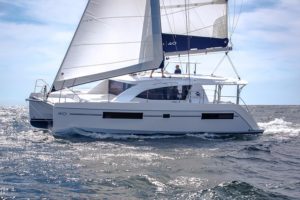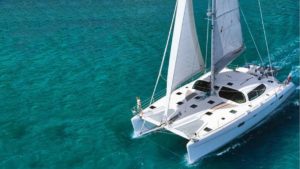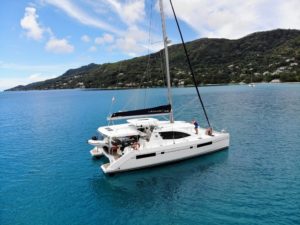CatamaranReviews.com
Leopard 43 catamaran.
The Leopard 43 is a popular cruising catamaran. The well thought out, comfortable design, and ability to sail short-handed makes an ideal blue-water cruising boat. Built with a high standard of construction, they are good value for money on the used catamaran market.
Table of Contents

DESIGN – INTERIOR & EXTERIOR
The Leopard 43 is a comfortable and reasonably fast passage maker able to be sailed short-handed. Based on the award-winning Leopard 42, the Leopard 43 is designed by Simonis and Voegd and built by Robertson and Caine, a large South African builder. These catamarans were built in two configurations, one for owners and one for the charter market. The owner’s version, called the Leopard 43 has three cabins and three heads. While the charter version, named the Moorings 4300, has a fitout of four cabins and four heads.
A solidly constructed hardtop provides good protection in the cockpit for enjoying life on the water. The hardtop also offers a convenient location for the solar panels and the traveler to mount to, reducing clutter in the cockpit. One unfavorable aspect of the design of the Leopard 43 is the bridge deck, which has a low clearance with the water and is known to slam in rough seas. Strong davits securely hold the dinghy, which is mounted on a full walk around duckboard on the transom. This is a practical design and convenient during sailing and provides excellent access to the tender and ocean at anchor. With a total of 74 Leopard 43’s built between 2004 and 2007, they remain a popular catamaran and don’t last long in the used catamaran marketplace.
Sailors on the Leopard 43 have easy access to the water with the large duckboard and the large sugar scoop steps. These would be very useful for entering the water to go snorkeling or pulling your freshly caught fish aboard. An outdoor shower is located at the port scoop is ideal for rinsing off afterward. There is plenty of room on the aft rail for the grill to be mounted.
Upfront, seats are mounted on the pulpit, creating a nice space to sit and watch the world go by or for enjoying sundowners. And the trampolines are a good size for both comfort and safety. Grab rails are mounted on the cabin top and are convenient when moving along the deck.
The helm is located on the starboard side with excellent visibility and protection. It is enhanced by a windscreen Bimini that attaches between the cabin rooftop and the hardtop for bad weather. The entire cockpit area has adequate protection from the hardtop, and clears can be rolled down quickly if poor weather were to arrive. The table in the cockpit has a wraparound lounge and can seat eight, using two additional seats. Most lines are run back to the cockpit and helm with an electric winch providing the muscle power. Additional winches are located on the mast.
Entry into the saloon from the cockpit is over a seaworthy raised bulkhead and through a large opening door. The adjacent side of the door are folding panels that open out for further ventilation and space. A thoughtful design in the cabin is the louvered forward windows, which provide very good protection from the sun. And the forward windows incorporate opening hatches for ventilation.
The lounge is located starboard, seating six with one on a moveable seat, and ample space is available for dining or cocktails and relaxing. The table does go down for extra sleeping berth, with the cushions stowed away in the port side v-berth. A large amount of convenient storage space is available underneath the lounge seats, perfect for food and drinks.
The U shaped galley is mounted up and forward on the port side. They are comprised of two sinks and a very thoughtfully recessed dish drying rack, which would be perfect for securing dishes while sailing. The separate fridge and freezer, two burner stove and oven with lots of counter space makes cruising life on this catamaran very comfortable. A chart table and navigation station is located on the starboard side. The wiring can be easily accessed behind the comprehensive electrical control panel at the navigation station.
ACCOMMODATIONS
The accommodation offers comfort and privacy, with ample room for guests to join in the adventure. The owner’s versions consist of three cabins and a single v-berth in the bow, with the owner’s berth taking up the entire starboard hull. Conveniently, a door closes the owner’s berth from the salon area for privacy. The other option, the charter version has four double berths and two single berths in the bows. The double cabins are spacious, with a private head in each and storage provided underneath the queen-sized beds.
The berths are equipped with shelving, cabin lights, reading lights, ventilation fans, closets with hanging space, and the owner’s cabin area also features a desk. Some berths have air conditioning, and depending on the model, it can be controlled separately for each berth. Removable ceiling panels are fitted throughout for ease of inspection and maintenance.
Overall, this catamaran has a well-designed and well finished interior fitout.
TECHNICAL SPECIFICATIONS
- LOA: 42.49 ft / 12.95 m
- LWL: 37.73 ft / 11.50 m
- Beam: 22.74 ft / 6.93 m
- S.A. (reported): 1,291.00 ft2 / 119.94 m2
- Draft (max): 4.00 ft / 1.22 m
- Displacement: 19,026 lb / 8,630 kg
- First Built: 2004
- Last Built: 2007
- Number Built: 74
- Builder: Robertson & Caine
- Designer: Simonis & Voogd
- Engine Type: Diesel x 2
- Engine HP: 58
- Fuel: 95 gals / 360 L
- Water: 206 gals / 780 L
PRICE RANGE
The market price of the Leopard 43 is in the range from $275,000 to $375,000 depending on the condition and version.
Overall, the Leopard 43 is a thoughtfully designed catamaran, and the ability to sail short-handed makes it an ideal blue-water cruising boat. As they are built with a high standard of construction, they provide good value for money. Although discontinued, they remain a popular catamaran, and with 74 Leopard 43’s built between 2004 and 2007, they can be seen sailing the oceans for some time to come.
Leopard 43 Specs
Make: leopard, catamaran rating, leopard 43 pictures, new catamaran reviews.

Seawind 1600

Privilege 585

Catamaran Makes
New reviews, most popular.
Great choice! Your favorites are temporarily saved for this session. Sign in to save them permanently, access them on any device, and receive relevant alerts.
- Sailboat Guide
Leopard 43 is a 42 ′ 5 ″ / 13 m catamaran sailboat designed by Simonis Voogd Design and built by Robertson & Caine between 2004 and 2007.
Rig and Sails
Auxilary power, accomodations, calculations.
The theoretical maximum speed that a displacement hull can move efficiently through the water is determined by it's waterline length and displacement. It may be unable to reach this speed if the boat is underpowered or heavily loaded, though it may exceed this speed given enough power. Read more.
Classic hull speed formula:
Hull Speed = 1.34 x √LWL
Max Speed/Length ratio = 8.26 ÷ Displacement/Length ratio .311 Hull Speed = Max Speed/Length ratio x √LWL
Sail Area / Displacement Ratio
A measure of the power of the sails relative to the weight of the boat. The higher the number, the higher the performance, but the harder the boat will be to handle. This ratio is a "non-dimensional" value that facilitates comparisons between boats of different types and sizes. Read more.
SA/D = SA ÷ (D ÷ 64) 2/3
- SA : Sail area in square feet, derived by adding the mainsail area to 100% of the foretriangle area (the lateral area above the deck between the mast and the forestay).
- D : Displacement in pounds.
Ballast / Displacement Ratio
A measure of the stability of a boat's hull that suggests how well a monohull will stand up to its sails. The ballast displacement ratio indicates how much of the weight of a boat is placed for maximum stability against capsizing and is an indicator of stiffness and resistance to capsize.
Ballast / Displacement * 100
Displacement / Length Ratio
A measure of the weight of the boat relative to it's length at the waterline. The higher a boat’s D/L ratio, the more easily it will carry a load and the more comfortable its motion will be. The lower a boat's ratio is, the less power it takes to drive the boat to its nominal hull speed or beyond. Read more.
D/L = (D ÷ 2240) ÷ (0.01 x LWL)³
- D: Displacement of the boat in pounds.
- LWL: Waterline length in feet
Comfort Ratio
This ratio assess how quickly and abruptly a boat’s hull reacts to waves in a significant seaway, these being the elements of a boat’s motion most likely to cause seasickness. Read more.
Comfort ratio = D ÷ (.65 x (.7 LWL + .3 LOA) x Beam 1.33 )
- D: Displacement of the boat in pounds
- LOA: Length overall in feet
- Beam: Width of boat at the widest point in feet
Capsize Screening Formula
This formula attempts to indicate whether a given boat might be too wide and light to readily right itself after being overturned in extreme conditions. Read more.
CSV = Beam ÷ ³√(D / 64)
Mainsail area: 76 m². Genoa area: 44 m². Engines: 2 x 29 hp diesels Most built for the charter trade. Owners version available (13) with different layout.
Embed this page on your own website by copying and pasting this code.
Discover Related Sailboats

YouTube Stars
YouTube sailing channels allow millions of us to experience the adventures of the high seas without casting off our own lines. We get an ...
- About Sailboat Guide
©2024 Sea Time Tech, LLC
This site is protected by reCAPTCHA and the Google Privacy Policy and Terms of Service apply.
- Aeolian Islands
- Amalfi Coast
- Italian Riviera
- Antigua & Barbuda
- Balearic Islands
- --> Split --> Dubrovnik --> Hvar --> Trogir --> Korcula --> Sukosan --> faq --> --> -->